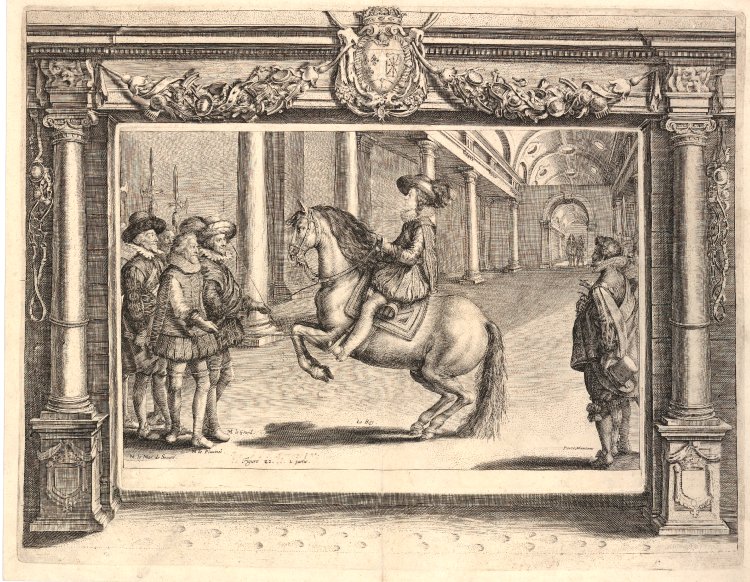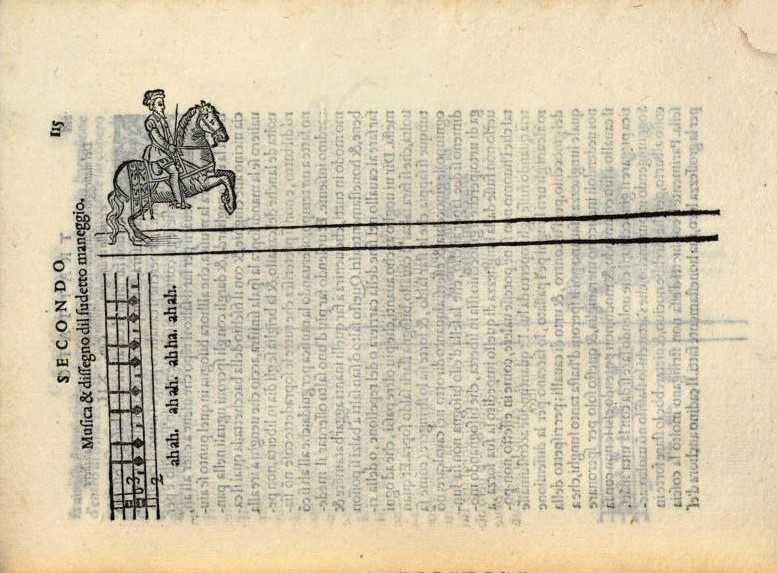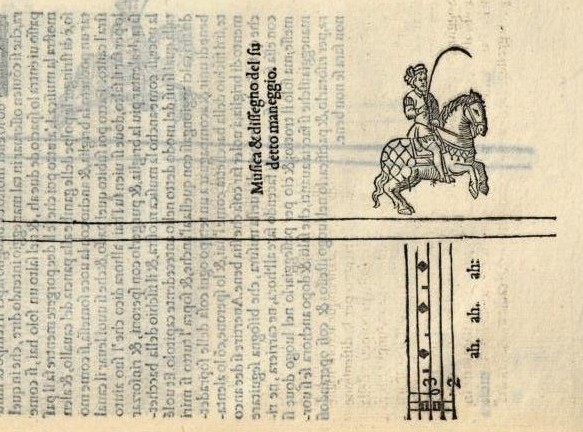“Maneggi and jumps”. The basic exercises of Renaissance horsemanship (Part 3)

National Gallery of Art, Washington D.C.
by Giovanni Battista Tomassini
In the late Middle Ages and during the Renaissance, horseback riding had a strong social importance. The horse held an essential symbolic function in defining the identity of the aristocratic classes and played a central role in most public events. With the horse’s strength and elegance and the splendor of his trappings, he contributed to make the nobility shine before common people during public cavalcades and feasts. Equitation was also an integral part of the rituals of the courts. It is no coincidence that some of the pages of the first equestrian treatise ever printed, Gli ordini di cavalcare (The Orders of riding 1550) by Federico Grisone, were devoted to how to present a horse in the presence of a prince or a king. On these occasions, as well as during the pageantry that preceded the fighting in jousts and tournaments, horses and riders performed exercises designed to show to the bystander the energy of the animal and the courage and skill of the rider. These exercises were primarily what today we call “school jumps” or “airs above the ground.”
In contrast to a fairly widespread belief, these exercises had an aesthetic, rather than military purpose. The authors of the sixteenth century, and later, are unanimous on this. According to Fiaschi, not only the “school jumps”, but even the “pesades” were dangerous for the combat horse because, when reared on his hind legs. the animal was in a vulnerable position with respect to the charge of any opponent.
… if you want to make some pesades, they should not be very high, because, besides that it would be ugly to see a horse who is accustomed in this way, it would also be detrimental every time that he would behave like this while he’s given encounter, because he could be easily knocked to the ground. This is what I dislike of so many pesades, especially in a war-horse (Fiaschi, 1556, II, 5, p. 99).

had an aesthetic, rather than military purpose.
William Cavendish, duke of Newcastle, La methode et invention
nouvelle de dresser les cheuaux, 1658, tav. 30
An opinion shared by Claudio Corte, author of Il cavallarizzo (The Horseman, 1562), according to whom the greatest risk was that, once trained to pesades and courbettes, the horse could perform them on it’s own initiative, to evade the control of the rider, leaving him exposed to the attacks of his opponents.
Young horses learn pesades easily, and once they have learned them they make them willingly, as they think that once they have done them they do not have to do anything else. For this reason if they are beaten with the spur they think they should not do anything else than stop and make a pesade. So they stop very often to rear against the will of the rider, and in a place where it is not required, and they do it even higher than what it is appropriate (CORTE, 1562, II, 15, p. 71r).

considered the pesades harmful to the war horse.
Antoine de Pluvinel, L’instruction du Roy en l’exercice de monter à cheval, 1625, figure 22
Even more explicit about the exclusively ludic purpose of the school jumps and about their harmfulness for war-horses is Pasquale Caracciolo, author of the monumental treatise La Gloria del cavallo (The glory of the horse, 1567). According to the Neapolitan writer and rider, training a horse to jumps, not only made him beautiful to see, but at the same time it increased his agility and sensitivity to the aids. In any case, before the training he recommended to carefully assess the attitudes of the animal, which had to have specific qualities of strength and docility. However, Caracciolo considered it a serious mistake to train a war-horse to these exercises since, according to him, not only they did not produce any benefit in battle, but they could be rather harmful.
Maybe someone will consider useless and vain that a man toils to teach these jumps to his horse; but he is wrong, because in addition to the fact that a horse that goes swaying from jump to jump it is beautiful to see, certainly, by lightening his arms and legs through these exercises, he becomes more agile and more ready for all the other virtues that are required. Just as though the ball game is not in itself necessary to the Rider, it cannot, however, be denied that in addition to giving him some ornament, it is also very beneficial to train him to the use of weapons. One must first consider the size, ability, and the inclination of the animal, and when these things are adequate, it is out of doubt that teaching to their horses these exercises is useful and honorable to young people eager to stay well on saddle, and that by means of this discipline, the horses will become every day more agile and lighter, while maintaining temperance and the prescribed order. But the one who would train a very fast horse, or one particularly suited to war, to these jumps and exercises, would be a fool, because in military operations they would rather produce hindrance and damage instead of any benefit to the Rider, as we have already said before (CARACCIOLO, 1567, p. 426)
On the other hand, as Jean-Claude Barry, who for seventeen years was Ecuyer of the Cadre Noir and a leading expert in the work of the “jumpers”, explains well: “knowing the preparation and accuracy they require, it is difficult to imagine performing the airs above the ground during a clash in which rapidity and responsiveness are vital and in which any inaccurate or involuntary action of the rider may be misunderstood by the horse. Moreover the weight of the harness and of the knight in armor was a handicap for the steed restricting his agility “(Barry, 2005, p.26).

Giovanni Battista Galiberto, Il cavallo da maneggio, 1650
The airs above the ground practiced at that time were slightly different from those still performed today in the great academies of classical equestrian art, like those of Vienna, Saumur, Jerez de la Frontera and Lisbon, which mainly refer to the codification of these exercises that took place in the eighteenth century. Unfortunately, the authors of the Renaissance treatises took it for granted that their readers knew the exercises they spoke about in their books and for this reason they did not dwell on in-depth and clear descriptions. Similarly, with the only exception of the treatise by Cesare Fiaschi, the works of the sixteenth century do not show significant illustrations that can clarify how the various exercises were performed. This makes it now more difficult to pinpoint the specific features of the different types of jumps that are mentioned in the works of the Renaissance masters. Therefore, in order to make the following description more explicit and precise we will refer to the plates from Fiaschi’s book, as well as to those published in later works, such as the one by the Duke of Newcastle, and as Il cavallo da maneggio (The manège horse), by the Neapolitan count Giovanni Battista Galiberto, colonel and master of riding in the service of King Ferdinand IV of Hungary and Bohemia. Although the work was published in Vienna in 1650, exactly a century after that of Grisone, it clearly refers to the terminology and techniques of Renaissance Italian horsemanship.

in the four major academies of Saumur, Lisbon, Jerez and Vienna
The first “air” mentioned in Fiaschi’s book is the so-called “galoppo raccolto” (collected canter). The author does not provide any description of this air, but noting the difficulty of explaining his execution, in words or with a design, he adds the score, specifying that “this measure and time should be respected if you want that the rider makes a group which is beautiful to see” (FIASCHI, 1556, II, 11, p. 114). With the verb “aggruppare” (to group) I think that the author means “perform jumps”, which in other texts are also called “groppi” (probably from “groppa” i.e. croup). Fiaschi says that to perform this exercise the rider must keep the horse collected, stimulating him with his calves and holding him rhythmically with the bridle, so that “he moves as much as he sways a little bit” (FIASCHI, 1556, II, 11, p. 114). Judging from this information and also from the accompanying illustration, it seems possible to identify the “galoppo raccolto” with what we now call terre à terre, a kind of two beat canter, in which the horse passes alternately from the front to the hind feet and that, since the eighteenth century, became the preparation air of all school jumps.

corresponds to what nowadays we call “terre à terre”.
Cesare Fiaschi, Trattato dell’imbrigliare, atteggiare e ferrare cavalli, 1556
Another exercise mentioned by Fiaschi is the so-called “air with jumps and bounds” (“maneggio con salti a balzi”). It is difficult to understand how this exercise was performed. Pasquale Caracciolo talks about a jump called “balzotto” (little bound), but he does not explain what it was. According to Barry, this would be the one that was later called ballotade, a jump in which the horse jumps in a horizontal position and extends the hind legs, as if to kick, but not extending them completely. Indeed, the picture in Fiaschi’s book shows the horse with all four feet off the ground, but with the hind feet under his body.

Cesare Fiaschi, Trattato dell’imbrigliare, atteggiare e ferrare cavalli, 1556
Several authors mentioned the so-called “a step and a jump” (“un passo e un salto”), which was also practiced in the version of “two steps and a jump.” Claudio Corte (II, 19) says that was taught to horses by training them to jump pieces of cloth held, stretched by aides, on the ground, placed two or three steps away from each other. Practically, the horse had to jump every one or two canter strides. This exercise was also called “galoppo gagliardo” (vigorous canter). From the description given by Claudio Corte, it seems that it was a sequence of jumps similar to the cabriole, interspersed with two or three strides of canter:
Do not think, for what I have said, that the cabriole and the step and a jump, or vigorous canter, are the same thing, because in the cabriole, as I already said, the jumps are made at every step, and a jump immediately follows the other, while in the vigorous canter it is not like this, but it goes two by two, or three by three, as the rider prefers: and the jumps are also always with kicks, while in that one [i.e. in the cabriole] the horse does not always kick, but he just can do it. It is more correct to say vigorous canter, rather than a step and a jump, because the jump is at the second and third step. (CORTE, 1562, II, 19, p. 74v)

was also called “vigorous canter”.
G. B. Galiberto, Il Cavallo da maneggio, 1650
A type of jump mentioned by all the books of that time is the “jump of the ram” (“salto a montone”), so called, says Pasquale Caracciolo, “because the horse jump in the same way in which the Rams jump” (CARACCIOLO 1567, p. 425 ). It is an exercise in which the horse jumps on the spot, kicking while he is off the ground and then comes back into the same position. According to Fiaschi, it was precisely this characteristic that distinguishes it from the “jumps and bounds”:
because when the horse makes the jump and bound, he pushes his waist forward, while doing the ram jump as it should, it is necessary that he falls straight in the place from where he lifts, going even higher (FIASCHI, 1556, II, 15, p. 122).

G.B. Galiberto, Il cavallo da maneggio, 1650
Finally, the most common jump is the so-called “capriola” (cabriole), the most spectacular of the airs above the ground still practiced. It consists of a jump in which the horse violently kicks when he is off the ground. According to Fiaschi, the cabriole differs from the ram jump because, in this case, when the horse jumps, he moves forward and does not fall in the same place. At that time, the horse kicked in the descending phase of the parable and landed on the front feet, while today generally he kicks at the height of the jump:
When you want to make the horse perform a cabriole jump or some jumps, which are so called because the goats [“capre” in Italian] jump in this way, you have to make him do as they do when they jump, that when they fall to the ground they raise their haunches (FIASCHI, 1556, II; 16, p. 124).

C. Fiaschi, Trattato dell’imbrigliare, atteggiare e ferrare cavalli, 1556
The “corvetta” (courbette) was also very popular. This is a school jump in which the horse raises the forelegs and then proceeds bounding on his hind legs. According to Corte, this characteristic movement would be at the origin of the name, since “we say corvetta from the raven [“corvo” in Italian], that when he is on the ground he goes forward with small bounds” (CORTE, 1562, II , 15, p . 72r ). It was considered a presentation air par excellence and was often performed during public cavalcades as an act of gallantry in the presence of ladies.

as an act of gallantry in the presence of ladies.
William Cavendish, duca di Newcastle, La methode et invention
nouvelle de dresser les cheuaux, 1658, tav. 26
The horses were also trained at “kicking”, as a preparation for school jumps. It should be considered that this kind of training was also shared by war horses, which were induced to kick on command in the melee, as shown in a detail of the famous painting by Paolo Uccello, Bernardino della Ciarda unhorsed (1438-1440), in which a chestnut horse is portrayed in the act of kicking with his hind legs.

a chestnut horse is portrayed in the act of kicking.
Paolo Uccello, Battle of San Romano (1438-1440), Firenze, Museo degli Uffizi
Finally, as we already saw in another article (The Spanish walk; classic exercise or circus trick?), that between the presentation airs there was also what we now call “Spanish walk” and at that time was called “far ciambetta.”
This concise discussion of the presentation airs concludes our survey of the main exercises described, or mentioned, in the Italian equestrian treaties of the Renaissance (see the previous articles: Part 1 and Part 2). Obviously, this concise description does not purport to exhaustively represent the vast field of the equestrian practices of the time, but primarily aims to highlight some aspects that have remained unchanged over the centuries, as well as to point out some significant differences.
Bibliograhy
BARRY, Jean-Claude, Traité des Airs relevés, Paris, Belin, 2005.
BARRY, Jean-Claude, Les airs relevés et leur histoire, in AA.VV., Les Arts de l’équitation dans l’Europe de la Reinassance. VIIe colloque de l’Ecole nationale d’équitation au Chateau d’Oiron (4 et 5 octobre 2002), Arles, Actes Sud, 2009, pp. 183-196.
CARACCIOLO, Pasquale, Gloria del cavallo, Venezia, Gabriel Giolito de’ Ferrari, (in 4°), 1566.
CORTE, Claudio, Il Cavallarizzo, Venezia, Giordano Zilletti, 1562.
FIASCHI, Cesare, Trattato dell’imbrigliare, atteggiare e ferrare cavalli, Bologna, Anselmo Giaccarelli, 1556.
GALIBERTO, Giovanni Battista, Il cavallo da maneggio, ove si tratta della nobilissima virtù del..,Vienna, Giacomo Kyrneri, 1650.



6 Comments
Join the discussion and tell us your opinion.
Merci de rétablir une vérité évidente que j’avais avancée dans ma thèse : celle sur l’usage des sauts. Malheureusement trop de gens pensent encore qu’ils sont utilisés sur les champs d
bataille.
Merci Corinne. Votre appréciation me rend très heureux. J’ai lu votre beau livre sur Les académies d’Art équestre dans la France d’Ancien Régime j’ai trouvé cela très intéressant.
http://www.edilivre.com/les-academies-d-art-equestre-dans-la-france-d-ancien-regime.html#.UzB1u6h5NG0
Finalmente sfatato un mito! Era davvero contro ogni logica pensare che arie così complicate fossero davvero utili in battaglia, sono contento che esistano le testimonianze di autori dell’epoca che confutino in modo inequivocabile la credenza dell’origine utilitaria dei salti di scuola. Complimenti
J’ai un exemplaire “La méthode et invention…” de 1658. Sachant qu’une douzaine seulement de cette première édition, je suis curieux de savoir où se trouve l’exemplaire que vous avez consulté. Très bon article.
Aujourd’hui tous les principaux textes de la tradition équestre sont accessibles en ligne. Il existe plusieurs versions numériques du traité de Newcastle, comme celle-ci, disponibles dans Google Livres:
https://books.google.it/books?id=P1hrdnaz7pcC&printsec=frontcover&hl=it&source=gbs_ge_summary_r&cad=0#v=onepage&q&f=false.
Merci pour votre appréciation pour mon travail.
GBT
Brilliant topic; excellent content, and well written. And I was beginning to think I was the only one left!